Understanding Ancient Landscapes in the Venetian Plain through an Integrated Geoarchaeological and Geophysical Approach
Abstract
1. Introduction
2. Materials and Methods
2.1. Analysis of Historical Documents and Archaeological Field Data
2.2. Multitemporal Analysis of Historical Aerial Photographs
- -
- analyze previous works to evaluate possible integration of the photo interpretations;
- -
- obtain metric indications;
- -
- gather the modifications in the organization of the territory, to acquire useful data to interpret the traces, eventually excluding a modern origin linked to the recent reclamations and hydraulic-agricultural interventions.
2.3. Multitemporal Analysis of Historical Cartography
2.4. Geophysical Measurements
2.5. Core Sample Analysis and Radiocarbon Dating
2.6. Visual Evaluation of Exposed Section
3. Results
4. Discussion
5. Conclusions
Author Contributions
Funding
Acknowledgments
Conflicts of Interest
References
- Bondesan, A.; Meneghel, M. Geomorfologia della Provincia di Venezia. Collana: Il Mito e la Storia; Serie maggiore; Esedra: Padova, Italy, 2004. [Google Scholar]
- Ragazzi, F.; Zamarchi, P. Carta dei Suoli della Provincia di Venezia, Scala 1:50.000; LAC: Firenze, Italy, 2008. [Google Scholar]
- Carton, A.; Bondesan, A.; Fontana, A.; Meneghel, M.; Miola, A.; Mozzi, P.; Primon, S.; Surian, N. Geomorphological evolution and sediment transfer in the Piave River watershed (north-eastern Italy) since the LGM. Géomorphologie 2009, 3, 37–58. [Google Scholar]
- Bondesan, A.; Primon, S.; Bassan, V.; Vitturi, A. Carta Delle Unità Geologiche Della Provincia di Venezia; Cierre: Verona, Italy, 2008. [Google Scholar]
- Veronese, F. Via Annia. Adria, Padova, Altino, Concordia, Aquileia. Progetto di Recupero e Valorizzazione di Un’antica Strada Romana; Il Poligrafo: Padova, Italy, 2009. [Google Scholar]
- Veronese, F. Via Annia II. Adria, Padova, Altino, Concordia, Aquileia. Progetto di Recupero e Valorizzazione di Un’antica Strada Romana; Il Poligrafo: Padova, Italy, 2011. [Google Scholar]
- Rosada, G.; Frassine, M.; Ghiotto, A.R. Viam Anniam Influentibus Palustribus Aquis Eververatam Tradizione, Mito, Storia e Katastrophé di una Strada Romana; Canova: Treviso, Italy, 2010. [Google Scholar]
- CaVe. Carta archeologica del Veneto I; Capuis, L., Leonardi, G., Pesavento Mattioli, S., Rosada, G., Eds.; coord. scient. L.; Bosio: Modena, Italy, 1988. [Google Scholar]
- Croce Da Villa, P. Stele funeraria romana da Ceggia (VE). In Studi di Archeologia Della X Regio in Ricordo di Michele Tombolani; Scarfì, B.M., Ed.; Roma, Italy, 1994; pp. 339–343. [Google Scholar]
- Magarotto, M. L’ambiente Antropico Delimitato Dalla SS 14 e Dagli Attuali Corsi del Piave e del Livenza Dall’epoca Romana All’affermarsi di Civitas Nova. Bachelor’s Thesis, Fac. di Lettere e Filosofia, Università degli Studi di Padova, Padua, Italy, 1984–1985. [Google Scholar]
- Giovani, E.; Rigoni, A.N. L’agro Opitergino e i Paleoalvei alla Sinistra del Piave dai dati del Remote Sensing, in Quaderni di Archeologia del Veneto; CEDAM: Padova, Italy, 1986; Volume II, pp. 135–139. [Google Scholar]
- Rosada, G. I Fiumi e i Porti Della Venetia Orientale: Osservazioni Intorno ad un Famoso Passo Pliniano; Portus Liquentiae: I Dati e i Problemi, in Aquileia Nostra: Bollettino Dell’associazione Nazionale per Aquileia, L; Aquileia Nostra: Aquileia, Italy, 1979; pp. 174–216. [Google Scholar]
- Bosio, L.; Rosada, G. Le presenze insediative nell’arco dell’Alto Adriatico dall’epoca romana alla nascita di Venezia. Dati e problemi topografici. In Da Aquileia a Venezia; Una mediazione tra l’Europa e l’Oriente dal II secolo a.C. al 6VI secolo d.C.; Libri Scheiwiller: Milano, Italy, 1989; pp. 509–567. [Google Scholar]
- Tozzi, P.; Harari, M. Eraclea Veneta. Immagine di una città Sepolta; Compagnia Generale Ripreseaeree: Parma, Italy, 1984. [Google Scholar]
- Dorigo, W. Venezie Sepolte nella Terra del Piave. Duemila Anni fra il Dolce e il Salso. 1994. Available online: https://aleph.mpg.de/F/9JH8L2FKU1AHY3N29182VTYD9GPSKK3NYJ1H3NGYBHFETLH63L-60733?func=full-set-set&set_number=116613&set_entry=000001&format=999 (accessed on 11 September 2020).
- Mozzi, P.; Fontana, A.; Ferrarese, F.; Ninfo, A.; Campana, S.; Francese, R. The Roman city of Altinum, Venice lagoon, from remote sensing and geophysical prospection. Archaeolog. Prospect. 2016, 23, 27–44. [Google Scholar] [CrossRef]
- Ninfo, A.; Fontana, A.; Mozzi, P.; Ferrarese, F. The map of Altinum, ancestor of Venice. Science 2009, 325, 577. [Google Scholar] [CrossRef] [PubMed]
- Ferri, R.; Calzolari, M. Il Contributo Dell’indagine Aerofotogrammetrica all’individuazione di Antichi Tracciati Stradali: L’esempio della Viabilità di Epoca Romana le Valli Grandi Veronesi e la Bassa Modenese, Miscellanea di Studi Archeologici e di Antichità, 3nd ed.; Aedes Muratoriana: Modena, Italy, 1989; pp. 111–132. [Google Scholar]
- Vermeulen, F.; Antrop, M. Ancient Lines in the Landscape. A Geo-Archaeological Study of Protohistoric and Roman Roads and Fields Systems in: Northwestern Gaul; Babesch. Bulletin Antieke Beschaving. Annual Papers on Classical Archaeology; Peeters Publishers: Leuven, Belgium, 2001; (Suppl. 7). [Google Scholar]
- Vacilotto, A. Capire i segni antichi della terra per governarla. Il caso incognito dell’agro meridionale di Opitergium. In R. PERNA, R. CARMENATI; Giuliodori, M., Piccinini, J., Eds.; Roma ed il Mondo Adriatico. Dalla Ricerca Archeologica alla Pianificazione del Territorio, Atti del Convegno Internazionale, Macerata, 18–20 maggio 2017, Volume I; Carte archeologiche, gestione del patrimonio e parchi archeologici: Roma, Italy, 2020; pp. 33–51, in corso di stampa. [Google Scholar]
- Zare, E.; Arshad, M.; Zhao, D.; Nachimuthu, G.; Triantafilis, J. Two-dimensional time-lapse imaging of soil wetting and drying cycle using EM38 data across a flood irrigation cotton field. Agric. Water Manag. 2020, 241. [Google Scholar] [CrossRef]
- Boaga, J. The use of FDEM in hydrogeophysics: A review. J. Appl. Geophys. 2017, 139, 36–46. [Google Scholar] [CrossRef]
- Anderson-Cook, C.M.; Alley, M.M.; Roygard, J.K.F.; Khosla, R.; Noble, R.B.; Doolittle, J.A. Differentiating soil types using electromagnetic conductivity and crop yield maps. Soil Sci. Society Am. J. 2002, 66, 1562–1570. [Google Scholar] [CrossRef]
- Kitchen, N.R.; Sudduth, K.A.; Drummond, S.T. Mapping of sand deposition from 1993 midwest floods with electromagnetic induction measurements. J. Soil Water Conserv. 1996, 51, 336–340. [Google Scholar]
- Robert, P. Characterization of soil conditions at the field level for soil specific management. Geoderma 1993, 60, 57–72. [Google Scholar] [CrossRef]
- Saey, T.; Van Meirvenne, M.; de Smedt, P.; Neubauer, W.; Trinks, I.; Verhoeven, G.J.; Seren, S. Integrating multi-receiver electromagnetic induction measurements into the interpretation of the soil landscape around the school of gladiators at Carnuntum. Eur. J. Soil Sci. 2013, 64, 716–727. [Google Scholar] [CrossRef]
- De Smedt, P.; Delefortrie, S.; Wyffels, F. Identifying and removing micro-drift in ground-based electromagnetic induction data. J. Appl. Geophys. 2016, 131, 14–22. [Google Scholar] [CrossRef]
- Abdu, H.; Robinson, D.A.; Jones, S.B. Comparing bulk soil electrical conductivity determination using the DUALEM-1S and EM38-DD electromagnetic induction instruments. Soil Sci. Soc. Am. J. 2007, 71, 189–196. [Google Scholar] [CrossRef]
- Corwin, D.L.; Rhoades, J.D. An improved technique for determining soil electrical conductivity-depth relations from above-ground electromagnetic measurements. Soil Sci. Soc. Am. J. 1982, 46, 517–520. [Google Scholar] [CrossRef]
- Corwin, D.L.; Rhoades, J.D. Establishing soil electrical conductivity-depth relations from electromagnetic induction measurements. Commun. Soil Sci. Plant Anal. 1990, 21, 861–901. [Google Scholar] [CrossRef]
- Friedman, S.P. Soil properties influencing apparent electrical conductivity: A review. Comput. Electron. Agric. 2005, 46, 45–70. [Google Scholar] [CrossRef]
- Doolittle, J.A.; Brevik, E.C. The use of electromagnetic induction techniques in soils studies. Geoderma 2014, 223, 33–45. [Google Scholar] [CrossRef]
- Allred, B.J.; Daniels, J.J.; Ehsani, M.R. Handbook of Agricultural Geophysics; CRC Press, Taylor and Francis Group: Boca Raton, FL, USA, 2008. [Google Scholar]
- Koganti, T.; Van De Vijver, E.; Allred, B.; Greve, M.; Ringgaard, J.; Iversen, B. Mapping of Agricultural Subsurface Drainage Systems Using a Frequency-Domain Ground Penetrating Radar and Evaluating Its Performance Using a Single-Frequency Multi-Receiver Electromagnetic Induction Instrument. Sensors 2020, 20, 3922. [Google Scholar] [CrossRef]
- Elmahdy, S.I.; Mohamed, M.M. Remote sensing and geophysical survey applications for delineating near-surface palaeochannels and shallow aquifer in the United Arab Emirates. Geocarto Int. 2015, 30, 723–736. [Google Scholar] [CrossRef]
- Fitterman, D.V.; Menges, C.M.; Kamali, A.M.; Jama, F.E. Electromagnetic mapping of buried paleochannels in eastern Abu Dhabi Emirate, UAE. Geoexploration 1991, 27, 111–133. [Google Scholar] [CrossRef]
- Kemna, A.; Binley, A.; Ramirez, A.; Daily, W. Complex resistivity tomography for environmental applications. Chem. Eng. J. 2000, 77, 11–18. [Google Scholar] [CrossRef]
- Rudolph, S.; van der Kruk, J.; von Hebel, C.; Ali, M.; Herbst, M.; Montzka, C.; Weihermüller, L. Linking satellite derived LAI patterns with subsoil heterogeneity using large-scale ground-based electromagnetic induction measurements. Geoderma 2015, 241–242, 262–271. [Google Scholar] [CrossRef]
- Evans, R.L.; Law, L.K.; Louis, B.S.; Cheesman, S. Buried paleo-channels on the new jersey continental margin: Channel porosity structures from electromagnetic surveying. Mar. Geol. 2000, 170, 381–394. [Google Scholar] [CrossRef]
- Bates, M.R.; Bates, C.R.; Whittaker, J.E. Mixed method approaches to the investigation and mapping of buriedQuaternary deposits: Examples from southern England. Archaeol. Prospect. 2007, 14, 104–129. [Google Scholar] [CrossRef]
- De Smedt, P.; Van Meirvenne, M.; Herremans, D.; De Reu, J.; Saey, T.; Meerschman, E.; Crombé, P.; De Clercq, W. The 3-D reconstruction of medieval wetland reclamation through electromagnetic inductionsurvey. Sci. Rep. 2013, 3, 1517. [Google Scholar] [CrossRef] [PubMed]
- Deiana, R.; Bonetto, J.; Mazzariol, A. Integrated Electrical Resistivity Tomography and Ground Penetrating Radar Measurements Applied to Tomb Detection. Surv. Geophys. 2018, 39, 1081–1105. [Google Scholar] [CrossRef]
- Tsokas, G.N.; Tsourlos, P.I.; Stampolidis, A.; Katsonopoulou, D.; Soter, S. Tracing a major Roman road in the area of Ancient Helike by resistivity tomography. Archaeol. Prospect. 2009, 16, 251–266. [Google Scholar] [CrossRef]
- Vacilotto, A. I Segni Della Terra per la Storia Dell’assetto Agrario di Opitergium. Ph.D. Thesis, Università di Roma “La Sapienza”, Roma, Italy, 2017. [Google Scholar]
- Guaitoli, M. Nota sulla Metodologia della Raccolta, della Elaborazione e della Presentazione dei Dati, in TARTARA P.; Torrimpietra (IGM 149 I NO); Forma Italiae: Firenze, Italy, 1999; pp. 357–365. [Google Scholar]
- Cambi, F.; Terrenato, N. Introduzione All’archeologia dei Paesaggi. 1998. Available online: https://www.docsity.com/it/f-cambi-n-terrenato-introduzione-all-archeologia-dei-paesaggi-roma-1994/2409147/ (accessed on 11 September 2020).
- Corsi, C.; Slapšac, B.; Vermeulen, F. Good Practise in Archaeological Diagnostics. Non-invasive Survey of Complex Archaeological Sites; Springer: Berlin, Germany, 2013. [Google Scholar]
- Piccarretta, F. Manuale di Fotografia Aerea; Uso Archeologico; L’Erma di Bretschneider: Roma, Italy, 1987. [Google Scholar]
- Piccarretta, F.; Ceraudo, G. Manuale di Aerofotografia Archeologica. Metodologia, Tecniche e Applicazioni; Edipuglia: Bari, Italy, 2000. [Google Scholar]
- Vacilotto, A.; Codato, D.; Novello, E. La cartografia dei Consorzi di bonifica: Recupero, analisi e valorizzazione. In Proceedings of the XXI Conferenza Nazionale ASITA, Trieste, Italy, 21–23 November 2017; pp. 1033–1040. [Google Scholar]
- Daily, W.A.A.; Ramirez, A.; Binley, A.; LaBrecque, D. Electrical resistivity tomography. Lead. Edge 2004, 23, 438–442. [Google Scholar] [CrossRef]
- DeGroot-Hedlin, C.; Constable, S. Occam’s inversion to generate smooth, two-dimensional models from magnetotelluric data. Geophysics 1990, 55, 1613–1624. [Google Scholar] [CrossRef]
- LaBrecque, D.J.; Morelli, G.; Daily, W.; Ramirez, A.; Lundegard, P. Occam’s inversion of 3D ERT data. In Three-Dimensional Electromagnetics; Spies, B., Ed.; SEG: Tulsa, OK, USA, 1999; pp. 575–590. [Google Scholar]
- Binley, A.; Ramirez, A.; Daily, W. Regularised image reconstruction of noisy electrical resistance tomography data. In Proceedings of the 4th Workshop of the European Concerted Action on Process Tomography, Bergen, Norway, 6–8 April 1995; Beck, M.S., Hoyle, B.S., Morris, M.A., Waterfall, R.C., Williams, R.A., Eds.; pp. 401–410. [Google Scholar]
- Bronk Ramsey, C. Bayesian analysis of radiocarbon dates. Radiocarbon 2009, 51, 337–360. [Google Scholar] [CrossRef]
- Reimer, P.J.; Bard, E.; Bayliss, A.; Beck, J.W.; Blackwell, P.G.; Bronk Ramsey, C.; Buck, C.E.; Cheng, H.; Edwards, R.L.; Friedrich, M.; et al. IntCal13 and Marine13 radiocarbon age calibration curves 0–50,000 years cal BP. Radiocarbon 2013, 55, 1869–1887. [Google Scholar] [CrossRef]
- Harris, E.C. Principles of Archaeological Stratigraphy; Academic Press Limited: London, UK, 1989. [Google Scholar]
- Galiazzo, V. I Ponti Romani; Catalogo Generale, Ed.; Canova: Treviso, Italy, 1995. [Google Scholar]
- Jahn, R.; Blume, H.P.; Asio, V.B.; Spaargaren, O.; Schad, P.; Langohr, R.; Brinkman, R.; Nachtergaele, F.O.; Pavel Krasilnikov, R. Guidelines for Soil Description; FAO: Rome, Italy, 2006. [Google Scholar]
- Cornaro, M. Scritture sulla laguna. In Antichi Scrittori D’idraulica Veneta. Volume II Parte II. Scritture Sopra la Laguna di Alvise Cornaro e di Cristoforo Sabbadino, Off. grafiche C.; Ferrari: Venezia, Italy, 1919; pp. 1442–1464. [Google Scholar]
- Mozzi, P.; Bini, C.; Zilocchi, L.; Becattini, R.; Mariotti Lippi, M. Stratigraphy, palaeopedology and palinology of Late Pleistocene and Holocene deposits in the landward sector of the lagoon of Venice (Italy), in relation to the ‘caranto’ level. Il Quat. Ital. J. Quat. Sci. 2003, 16, 193–210. [Google Scholar]
- Mozzi, P.; Ferrarese, F.; Fontana, A. Integrating digital elevation models and stratigraphic data for the reconstruction of the post-LGM unconformity in the Brenta alluvial megafan (North-Eastern Italy). Alp. Med. Quat. 2013, 26, 41–54. [Google Scholar]
- Fontana, A.; Mozzi, P.; Marchetti, M. Alluvial fans and megafans along the southern side of the Alps. Sedim. Geol. 2014, 301, 150–171. [Google Scholar] [CrossRef]
- Rossato, S.; Mozzi, P. Inferring LGM sedimentary and climatic changes in the southern Eastern Alps foreland through the analysis of a 14C ages database (Brenta megafan, Italy). Quat. Sci. Rev. 2016, 148, 115–127. [Google Scholar] [CrossRef]
- Rossato, S.; Carraro, A.; Monegato, G.; Mozzi, P.; Tateo, F. Glacial dynamics in pre-Alpine narrow valleys during the Last Glacial Maximum inferred by lowland fluvial records (northeast Italy). Earth Surf. Dyn. 2018, 6, 809–828. [Google Scholar] [CrossRef]
- Fontana, A.; Mozzi, P.; Bondesan, A. Alluvial megafans in the Venetian–Friulian Plain (north-eastern Italy): Evidence of sedimentary and erosive phases during Late Pleistocene and Holocene. Quat. Int. 2008, 189, 71–90. [Google Scholar] [CrossRef]
- Floris, M.; Fontana, A.; Tessari, G.; Mulè, M. Subsidence zonation through satellite interferometry in coastal plain environments of NE Italy: A possible tool for geological and geomorphological mapping in urban areas. Remote Sens. 2019, 11, 165. [Google Scholar] [CrossRef]
- Schmedt, G. La prospezione aerea nella ricerca archeologica. In Proceedings of the Convegno Internazionale Sulla Tecnica e Diritto nei Problemi Della Odierna Archeologia, Venezia, Italy, 22–24 May 1962; pp. 66–93. [Google Scholar]
- Tozzi, P. Memoria della Terra. Storia Dell’uomo; La Nuova ItaliaFirenze: Firenze, Italy, 1987. [Google Scholar]
- Masiero, E. La strada “in levada” nell’agro nord-occidentale di Adria, in JAT, IX, Roma, Italy. 1999, pp. 107–120. Available online: https://www.gcss.it/easyweb/w7044/index.php?EW_T=M1&EW_FL=w7044/ew_limiti.html&EW4_DLL=10&EW4_DLP=10&EW4_NVR=&EW4_NVT=&EW4_NMI=&EW4_CJL=1&NOICONE=1&PHPMSG=1&lang=ita&REC1MEMO=1&EW4_PY=KW=MASIERO&EW_RM=10&EW_EP=KW=MASIERO&EW_RP=2&&EW_P=LSPHP&EW_D=W7044&EW=0002562 (accessed on 11 September 2020).
- Maragno, S. Rilievo topografico di un tratto del decumano massimo nella centuriazione fossile dell’ager Atrianus. In La Ricerca Archeologica di Superficie in Area Padana; Atti del workshop (Villadose, 1 ottobre 1994), a cura di E. Maragno, Stanghella (Padova); 1996; pp. 383–386. Available online: http://www.centuriazione.it/quaderni_win.asp?id=84 (accessed on 11 September 2020).
- Bonetto, J. Le vie Armentarie tra Patavium e la Montagna; Zoppelli: Dosson, Italy, 1997. [Google Scholar]
- De Guio, A. ii Progetto Alto-Medio Polesine–Basso Veronese: Sesto Rapporto, in Quaderni di Archeologia del Veneto, IX. 1993, pp. 170–186. Available online: https://culturaveneto.it/it/web/cultura/volumi-vi-x (accessed on 11 September 2020).
- Rosada, G. Altino e la via della transumanza nella Venetia centrale, In Proceedings of the Pecus. Man and Animal in Antiquity Conference, Swedish Institute, Rome, Italy, 9–12 September 2002; Santillo Frizell: Roma, Italy, 2004; pp. 71–83. [Google Scholar]
- Calzolari, M. Aspetti del territorio in epoca romana: Acque, bonifiche e insediamenti. In Da Palus Maior a S. Biagio in Padule. Uomini e Ambiente nella Bassa Modenese dall’Antichità al Medioevo; Dini: Modena, Italy, 1984; pp. 35–76. [Google Scholar]
- Frassine, M. Palus in Agro. Aree Umide, Bonifiche e Assetti Centuriali in Epoca Romana, Collana: Agri Centuriati. Supplementa; Fabrizio Serra, Ed.; Pisa-Roma: Roma, Italy, 2013. [Google Scholar]
- Franceschelli, C.; Marabini, S. Lettura di un Territorio Sepolto. La Pianura Lughese in età Romana; Collana “Studi e Scavi”, Dipartimento di Archeologia dell’Università di Bologna; AnteQuem: Bologna, Italy, 2007; p. 224. [Google Scholar]
- Matteazzi, M. Il paesaggio Centuriato a sud di Padova: Una Nuova Lettura Dallo Studio Archeomorfologico del Territorio. “Agri Centuriati”; Fabrizio Serra, Ed.; Pisa-Roma, 2014; pp. 9–29. [Google Scholar]
- Pauli Diaconi, Historial Langobardorum, III; Istituto Storico Italiano: Roma, Italy, 1918; pp. 23–24.
- Fontana, A.; Frassine, M.; Ronchi, L. Geomorphological and Geoarchaeological Evidence of the Medieval Deluge in the Tagliamento River (NE Italy). In Fontana A. and Herget J. Palaeohydrology; Springer: Cham, Switzerland, 2020; pp. 97–116. [Google Scholar]
- Pinna, M. Le Variazioni del Clima. Dall’ultima Grande Glaciazione alle Prospettive per il XXI Secolo; Franco Angeli: Milano, Italy, 1996. [Google Scholar]
- Pavanello, G. Di un’antica laguna scomparsa (la laguna Eracliana). In Arch. Veneto-Tridentino, 3nd ed.; Premiate officine grafiche C. Ferrari: Venice, Italy, 1923. [Google Scholar]

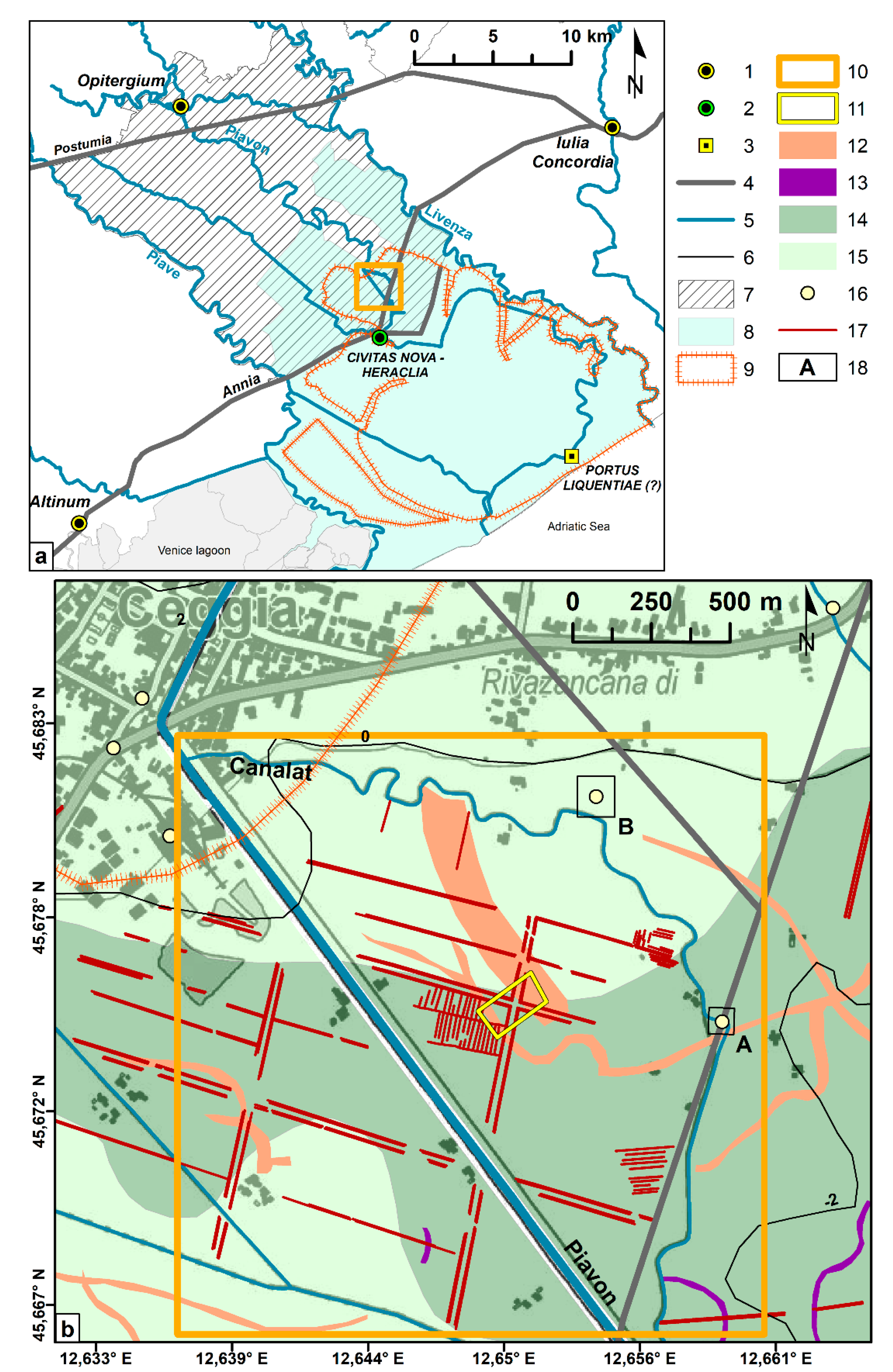
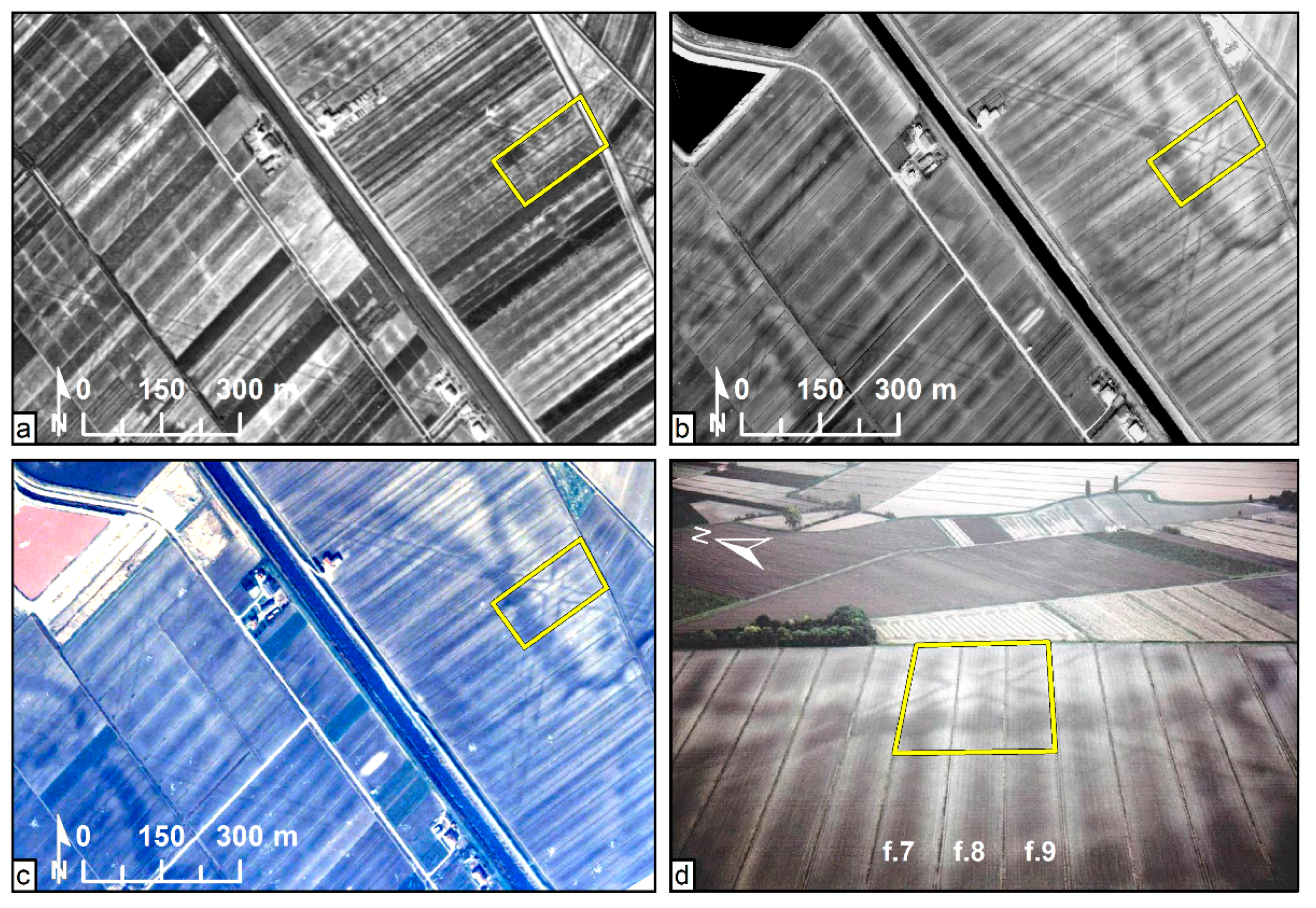
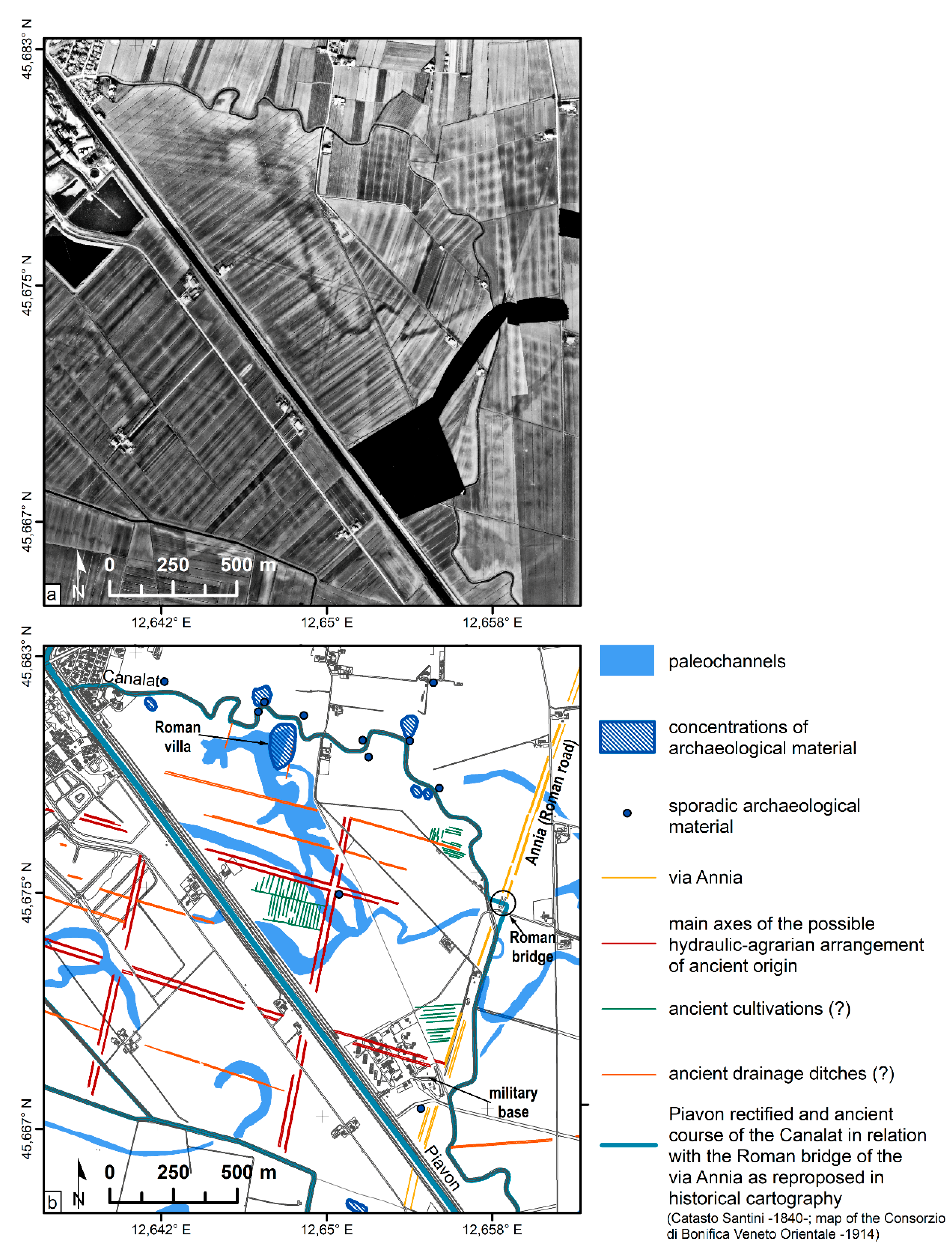
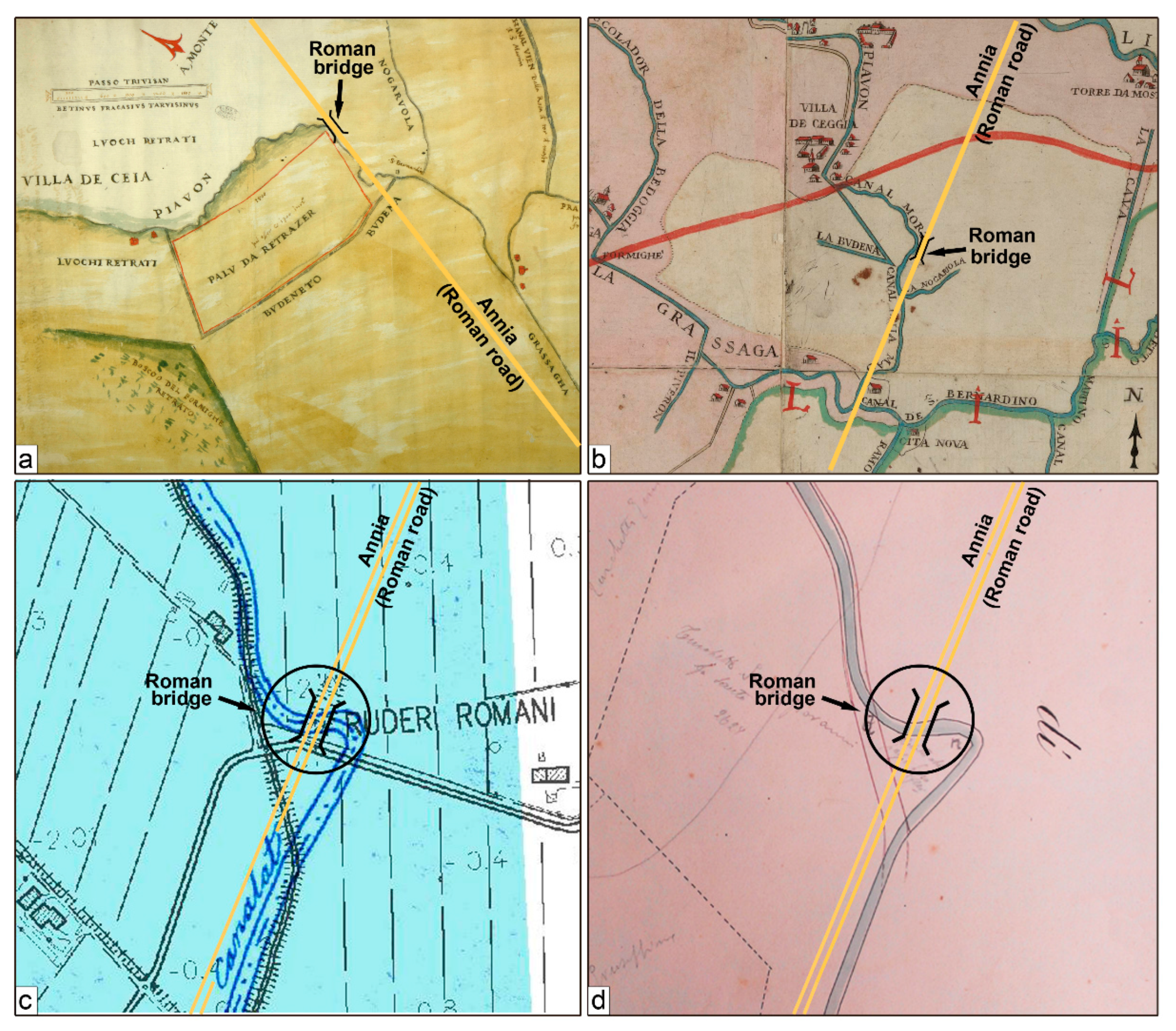
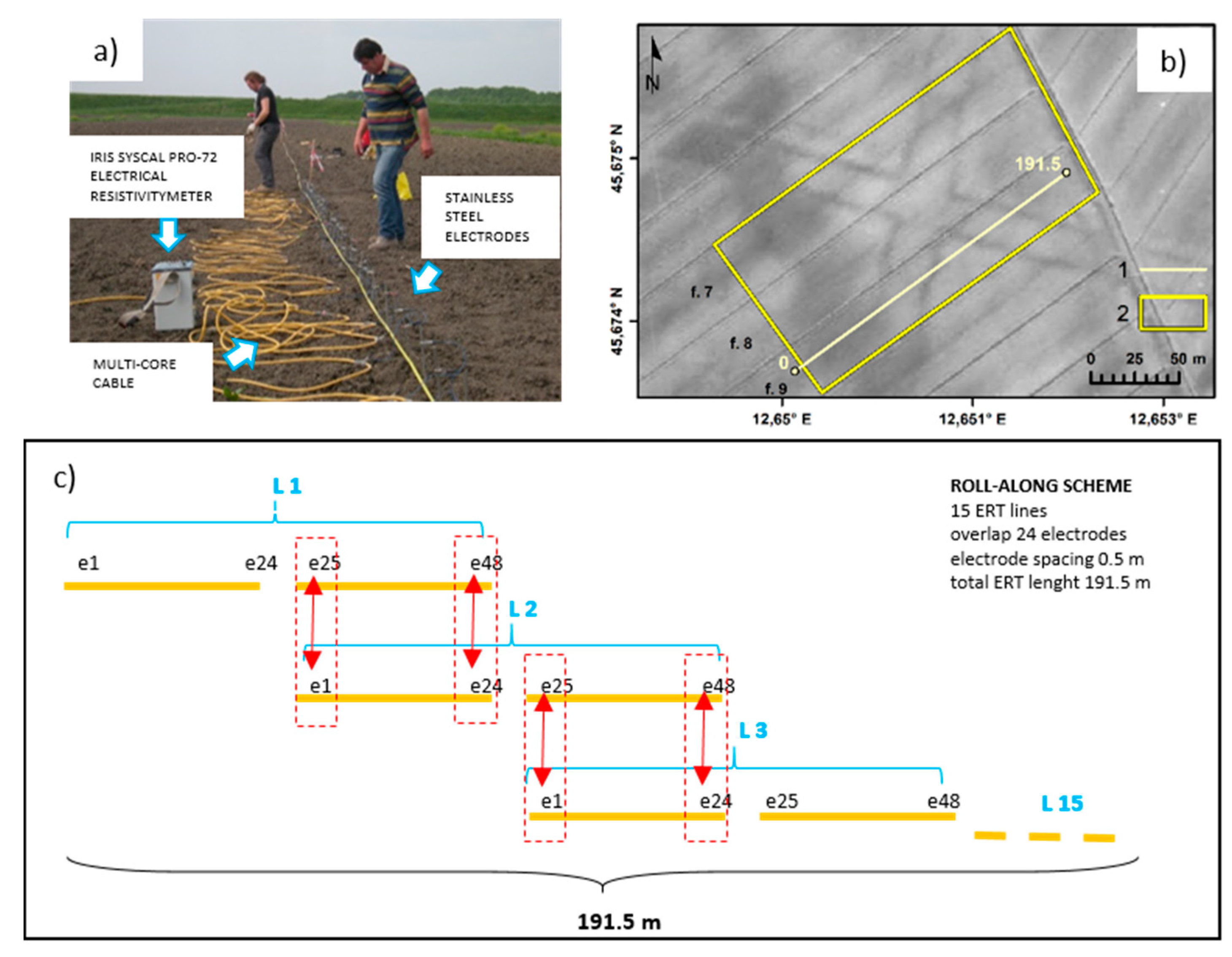
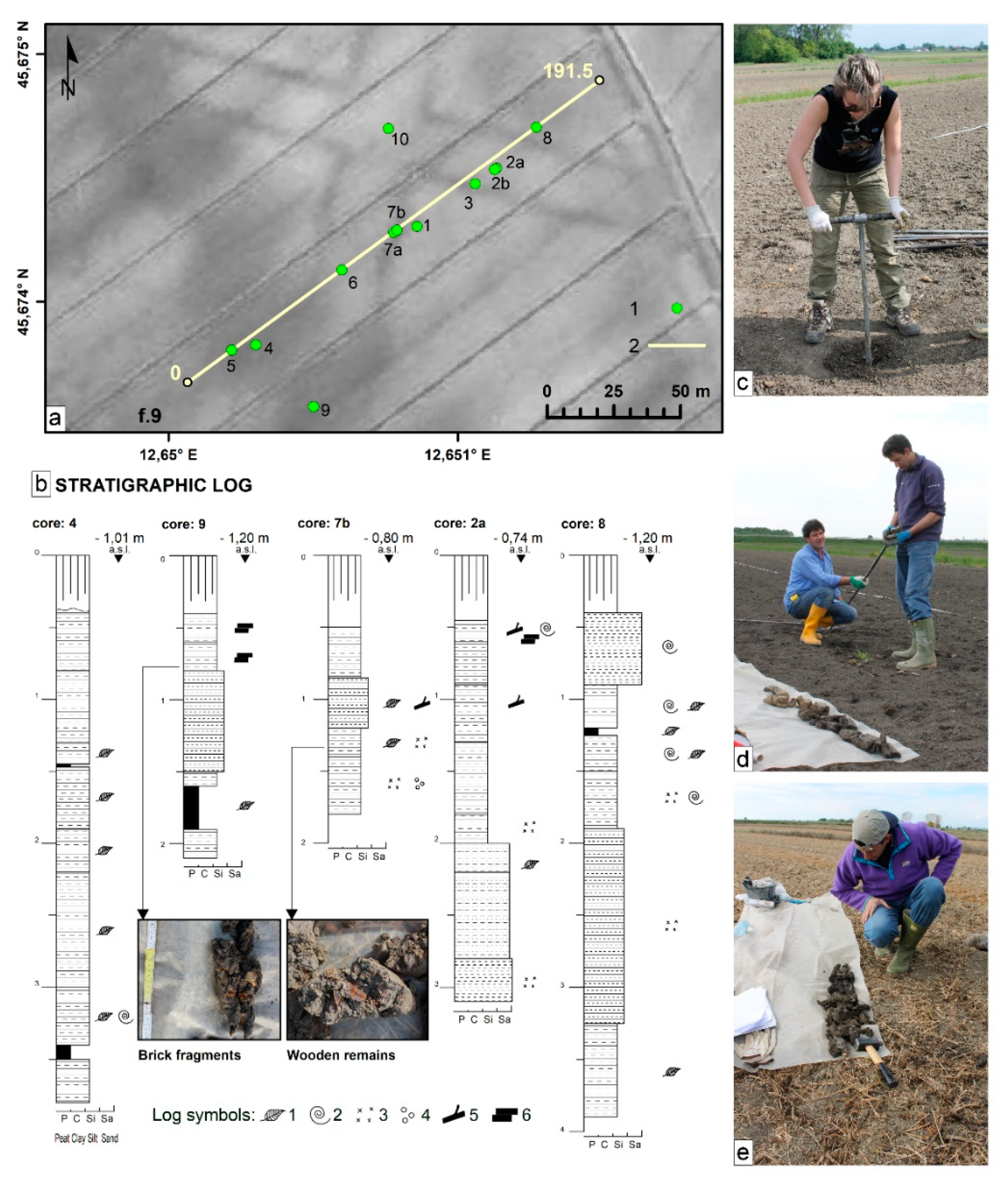
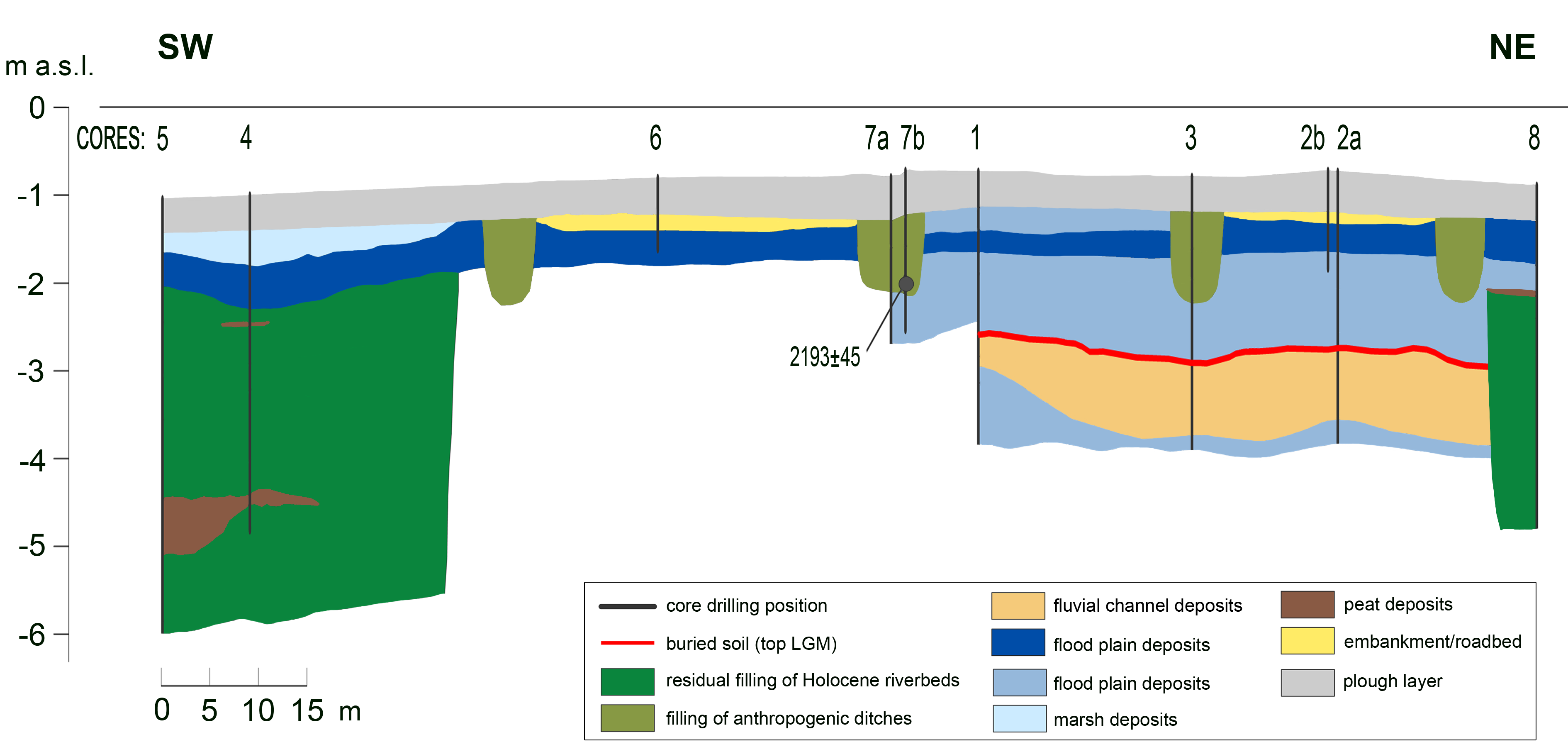
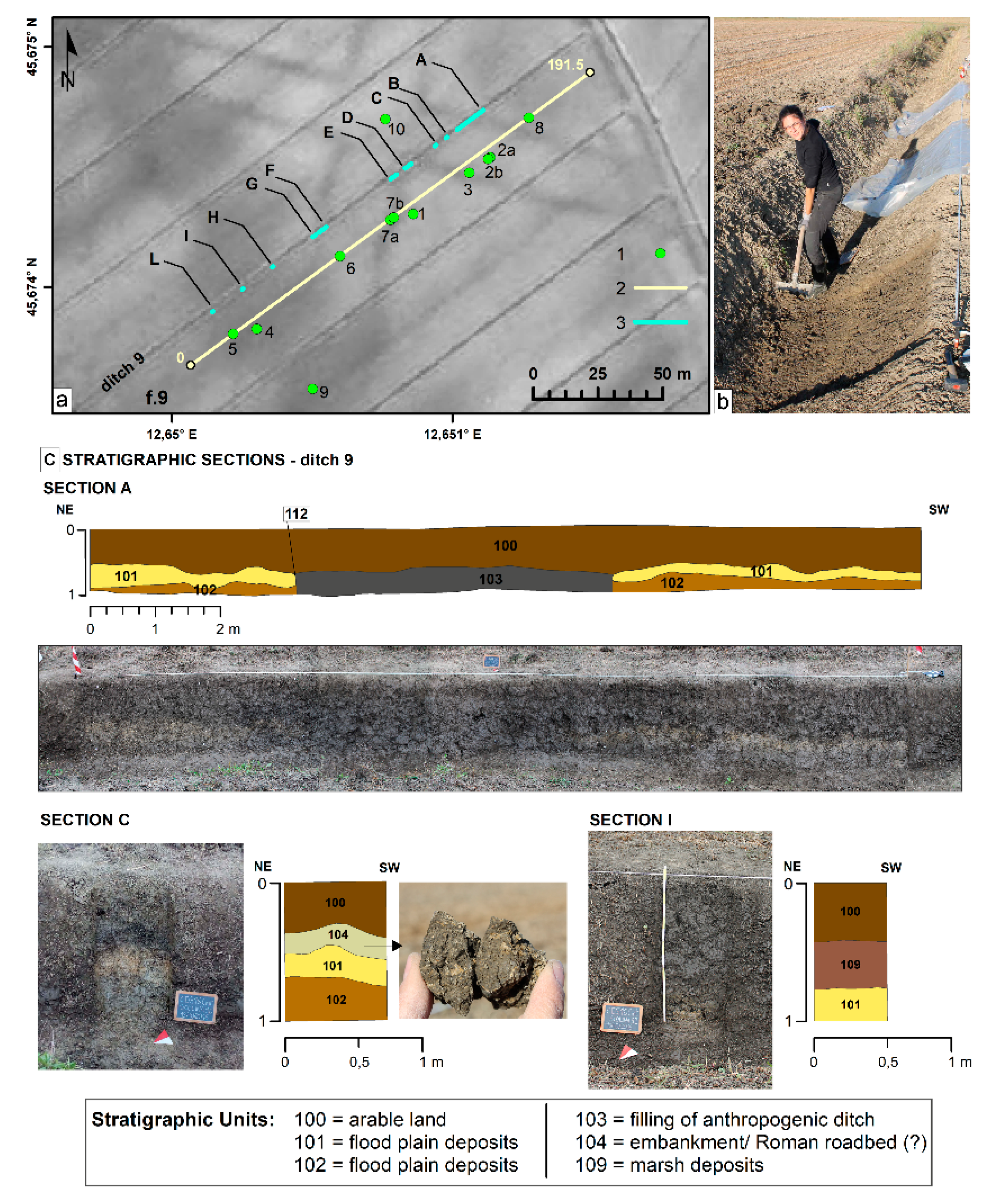

| Flight | Archive | Date | Type of Recording | Focal Length (mm) | Flying Height (m) | Average Frame Scale |
|---|---|---|---|---|---|---|
| ReVen 1999 | Veneto Region | 19 March 1999 | Analog b/w frame (23 cm × 23 cm) | 153, 31 | 2500 | 1:16,000 |
| ReVen 1990 | Veneto Region | 20 March 1990 | Analog color frame (23 cm × 23 cm) | 152, 82 | 3000 | 1:20,000 |
| ReVen 1983 | Veneto Region | 16–17 March 1983 | Analog b/w frame (23 cm × 23 cm) | 153, 13 | 2600 | 1:17,000 |
| GAI 1954 | IGM | 11 April 1954 | Analog b/w frame (23 cm × 23 cm) | 153, 154 | From 5000 to 10,000 | From 1:30,000 to 1:62,000 |
| IGM 1937 | IGM | 1937 | Analog b/w frame (13 cm × 18 cm) | n.a. | From 1400 to 3400 | From 1:11,000 to 1:20,000 |
| Date | Conservation Institute | Cartographic Code | Title |
|---|---|---|---|
| 1960 ca. | CBVO—(Consorzio di Bonifica Veneto Orientale) | Comune di Ceggia, FF. 2,4, 22 | Piano quotato |
| 1952 | IGM | F.39 III SE e F52 IV-NE | S. Stino di Livenza e Passarella |
| 1938 | IGM | F.39 III SE e F52 IV-NE | S. Stino di Livenza e Passarella |
| 1924 | IGM | F.39 III SE e F52 IV-NE | S. Stino di Livenza e Passarella |
| 1920 ca. | CBVO | Settore Tecnico: Progetti-Consorzio di Bonifica Bella Madonna | Comprensorio di bonifica |
| 1914 | CBVO | Settore Tecnico: Progetti-Consorzio di Bonifica Bella Madonna | Base catastale con indicazioni degli interventi da eseguire sulla rete scolante: rettifica ansa del Canalat |
| 1890–1891 | IGM | F.39 III SE e F52 IV-NE | S. Stino di Livenza e Passarella |
| 1840 (ca.) | CBVO | Settore Catasto: Fossà | Mappa del comune censuario di Fossà con Palazzetto, distretto VII di San Donà di Piave-Catasto Santini |
| 1807–1852 | ASVE | 74-Fossà con Palazzetto | Catasto Austriaco |
| 1818–1829 | Kriegsarchiv-Austrian State Archives | --- | Second Military Survey |
| 1798–1805 | Kriegsarchiv-Austrian State Archives | --- | Topographisch-geometrische Kriegskarte von dem Herzogthum Venedig |
| 1789 | CMC (Civico Museo Correr) | Provenienze Diverse, C 840.4 | Topografia del corso delle acque del basso Trevigiano |
| 1675 | ASVE | Miscellanea Mappe, 1275 | Mappa delle terre comprese tra la Livenza e il Piavon |
| 1641 | ASVE | Savi ed Esecutori alle Acque, Piave, r.106, dis.16 | Piave (fiume). Il Piave da Ponte di Piave al suo sbocco a mare, con vasta zona di terre arative, pascolive, boschive, a vigneti e valli, prative e paludose ed estesa fascia litoranea da Sant’Erasmo al porto di Caorle |
| 1639 | ASVE | Savi ed Esecutori alle Acque, Piave, r.106, dis.15 | Piave ed altri fiumi. Regolazione del Piave, Livenza, Sile, Zero, ed altri fiumi minori nel territorio, confluenti nel mare. |
| 1628 | ASVE | Miscellanea Mappe, 1274 | Mappa di beni siti nelle adiacenze del Piavon e Magnadola |
| 1607 | ASVE | Beni Inculti Treviso-Friuli, rot.414, m.10/B, dis.3 | Trevigiano (territorio). Comprensorio tra Piave e Livenza |
| 1568 | ASVE | Mensa Patriarcale, 42-55(16) | Villa de Ceia-Palu da retrazer |
| Core and Depth (cm) | LabCode | Radiocarbon Age (yr BP) | δ13C (‰) | Calibrated Age B.C. [Start-End] Probability % | Material | Elevation (m a.s.l.) | Latitude | Longitude |
|---|---|---|---|---|---|---|---|---|
| Core 7b 135 cm | LTL1687A | 2193 ± 45 | −29.8 ±0.2 | [384,156] 93,5% [134,115] 1,9% | wood | −0,80 | 45,6742° N | 12,6508° E |
© 2020 by the authors. Licensee MDPI, Basel, Switzerland. This article is an open access article distributed under the terms and conditions of the Creative Commons Attribution (CC BY) license (http://creativecommons.org/licenses/by/4.0/).
Share and Cite
Vacilotto, A.; Deiana, R.; Mozzi, P. Understanding Ancient Landscapes in the Venetian Plain through an Integrated Geoarchaeological and Geophysical Approach. Remote Sens. 2020, 12, 2973. https://doi.org/10.3390/rs12182973
Vacilotto A, Deiana R, Mozzi P. Understanding Ancient Landscapes in the Venetian Plain through an Integrated Geoarchaeological and Geophysical Approach. Remote Sensing. 2020; 12(18):2973. https://doi.org/10.3390/rs12182973
Chicago/Turabian StyleVacilotto, Alice, Rita Deiana, and Paolo Mozzi. 2020. "Understanding Ancient Landscapes in the Venetian Plain through an Integrated Geoarchaeological and Geophysical Approach" Remote Sensing 12, no. 18: 2973. https://doi.org/10.3390/rs12182973
APA StyleVacilotto, A., Deiana, R., & Mozzi, P. (2020). Understanding Ancient Landscapes in the Venetian Plain through an Integrated Geoarchaeological and Geophysical Approach. Remote Sensing, 12(18), 2973. https://doi.org/10.3390/rs12182973







